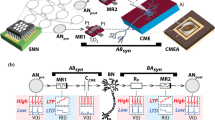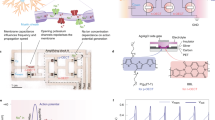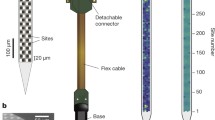Abstract.
Future hybrid neuron-semiconductor chips will consist of complex neural networks that are directly interfaced to electronic integrated circuits. They will help us to understand the dynamics of neuronal networks and may lead to novel computational facilities. Here we report on an elementary step towards such neurochips. We designed and fabricated a silicon chip for multiple two-way interfacing, and cultured on it pairs of neurons from the pedal ganglia of the snail Lymnaea stagnalis. These neurons were joined to each other by an electrical synapse, and to the chip by a capacitive stimulator and a recording transistor. We obtained a set of neuroelectronic units with sequential and parallel signal transmission through the neuron–silicon interface and the synapse, with a bidirectionally interfaced neuron-pair and with a signal path from the chip through a synaptically connected neuron pair back to the chip. The prospects for assembling more involved hybrid networks on the basis of these neuroelectronic units are considered.
Similar content being viewed by others
Author information
Authors and Affiliations
Additional information
Received: 13 April 2000 / Accepted in revised form: 29 September 2000
Rights and permissions
About this article
Cite this article
Jenkner, M., Müller, B. & Fromherz, P. Interfacing a silicon chip to pairs of snail neurons connected by electrical synapses. Biol Cybern 84, 239–249 (2001). https://doi.org/10.1007/s004220000218
Issue Date:
DOI: https://doi.org/10.1007/s004220000218




